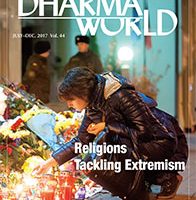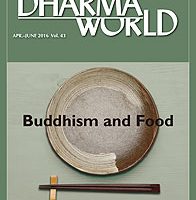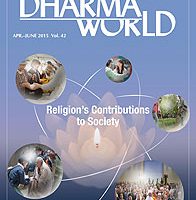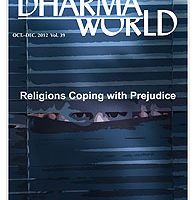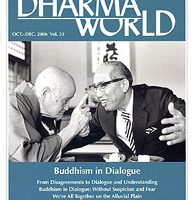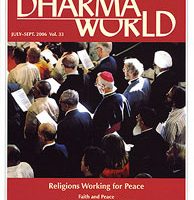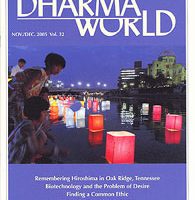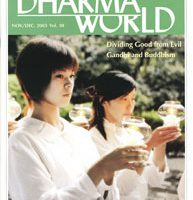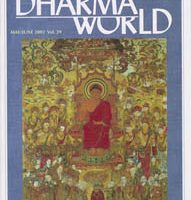January-February 2003, Volume 30(PDF)
Emerging Forms of Spirituality
Emerging Forms of Spirituality by Mark R. Mullins
The new information technology has now enabled the exploration of various spiritual paths and traditions free of both the direction of a priestly class of religious professionals and the control and constraints of religious institutions.
Mark R. Mullins is professor of religion in the Faculty of Comparative Culture, Sophia University. He has published widely on the transplantation and indigenization of world religions and the role of new religious movements in modern societies. He is the author and coeditor of a number of books, including Religion and Society in Modern Japan, Christianity Made in Japan, and Religion and Social Crisis in Japan.
The Roots of Japanese Spirituality: A Linguistic Exploration by Toji Kamata
Going beyond views of spirituality as the source of wisdom and compassion, this essay describes it as the compass of life, the fundamental power and orientation directing and driving life, and the indicator and magnetic needle of life.
Toji Kamata is a professor at the Kyoto University of Art and Design and a member of the board of directors of the Association for Shinto and Religious Studies. He received his Litt.D. from the University of Tsukuba. He is the author of numerous books on religion, folklore, and spirituality. He also composes songs on Shinto themes, which he performs in live concerts.
Drifting Faith: Civil Society and Public Philosophy in Japan by Tomoya Kaji
In the new public sphere, each individual is supposed to have an image of the ideal society and possess personal aspirations, to link up with others, and work for a better society.
Tomoya Kaji is professor of urban management and local government at Meiji Gakuin University. Previously, he was a visiting fellow at Princeton University (1997–99). He has served in many consultant positions to the United Nations and to Japanese governments at various levels and has written extensively on issues related to urban government and management.
A Vision of the Religion of the Future by Soho Machida
Belief in a God with a specific name and attributes will one day be replaced by a deepening belief in Something Great that is the cosmic will, and the distinction between monotheism and polytheism will become irrelevant.
Soho Machida spent twenty years as a Zen monk at Daitokuji monastery, Kyoto, before moving to the United States, where he received a master’s degree in theological studies from Harvard University and a Ph.D. from the University of Pennsylvania. He has taught at Princeton University and the National University of Singapore, and is now a professor at the Tokyo University of Foreign Studies. He has written extensively on religion and ethics.
A Reflection: Religion and Science in Global Society by Kuniko Miyanaga
Religion and science claim to know the ultimate truth, although their ultimate truths are unverifiable. They share the same barrier of human thought, although the ways in which they connect to that ultimate truth are different.
Kuniko Miyanaga is a social anthropologist. At present she is a visiting associate in research at the Edwin O. Reischauer Institute of Japanese Studies, Harvard University. She received a Ph.D. in anthropology from the University of British Columbia in 1983 and taught as a professor at International Christian University, Tokyo, until 2001. She is the author of several books on the theme of globalization and identity.
War, Environmental Destruction, and Religion: The Spiritual World of Hayao Miyazaki’s Nausicaa of the Valley of the Wind by Martin Repp
The Spiritual World of Hayao Miyazaki’s Nausicaa of the Valley of the Wind
Martin Repp holds a Th.D. from Marburg University and a postgraduate title (Habilitation) from Heidelberg University. From 1991 to 2002 he was associate director of the NCC (National Christian Council in Japan) Center for the Study of Japanese Religions, in Kyoto, and editor of its journal, Japanese Religions. Since 2002 he has been coordinator of the Interreligious Studies in Japan Program at the NCC Center. In 2004 he became professor of comparative religion and theology in the Graduate School of Jodo-shinshu Studies of Ryukoku University.
Reflections
Learning throughout Life by Nichiko Niwano
Although birth, aging, sickness, and death are the human lot, the younger generation tends to have a strong aversion to thoughts of aging. Meanwhile, more and more mature people are perplexed about how to live after retirement. What can we do to age in a fulfilling way?
Nichiko Niwano is president of Rissho Kosei-kai and the Niwano Peace Foundation, a president of the World Conference of Religions for Peace (WCRP), and chairman of the Japanese Association of Religious Organizations.
Achieving Peace in a Globalized World by Nikkyo Niwano
This essay is part of a continuing series of translations from a volume of inspirational writings by the late founder of Rissho Kosei-kai. DHARMA WORLD will continue to publish these essays because of their lasting value as guidance for the practice of one’s daily faith.
Nikkyo Niwano, the late founder of Rissho Kosei-kai, was an honorary president of the World Conference of Religions for Peace (WCRP) and was honorary chairman of Shinshuren (Federation of New Religious Organizations of Japan) at the time of his death in October 1999.
The Stories of the Lotus Sutra
The Jewel in the Topknot by Gene Reeves
The Buddha has given many gifts and treasures, many sutras, and many practices, but there is one that stands above all the others–the Lotus Sutra.
Gene Reeves is currently studying, teaching, and writing on Buddhism in Tokyo. A consultant and teacher at Rissho Kosei-kai, he was recently a research fellow at Rikkyo University. Before coming to Japan in 1989, Dr. Reeves was the dean of Meadville/Lombard Theological School and professorial lecturer in the Divinity School of the University of Chicago.
Conference Report
WCRP Europe Meeting in Italy Focuses on the Role of the Media by Eva Ruth Palmieri
Buddhist Living
Making a Dream Come True by Noriko LaMar
A Japanese member of Rissho Kosei-kai now living in the United States addressed the Los Angeles branch meeting on June 27, 2004, the day the organization’s president, Rev. Nichiko Niwano, visited the branch. This is a slightly edited version of her talk.
Noriko LaMar is director of the English Group at Rissho Kosei-kai of Los Angeles.
Gotama Buddha (70)
The Distribution and Veneration of the Buddha’s Relics by Hajime Nakamura
One man came forth to mediate among the groups disputing to receive the relics, saying he would divide them fairly among the Buddha’s followers.
The late Dr. Hajime Nakamura, an authority on Indian philosophy, was president of the Eastern Institute in Tokyo and a professor emeritus of the University of Tokyo at the time of his death in October 1999. This ongoing series is a translation of Gotama Buddha, vol. 2 (Tokyo: Shunjusha, 1992).
Threefold Lotus Sutra: A Modern Commentary (80)
The Sutra of the Lotus Flower of the Wonderful Law
Chapter 8: The Five Hundred Disciples Receive the Prediction of Their Destiny (4) by Nikkyo Niwano
This is the eightieth installment of a detailed commentary on the Threefold Lotus Sutra by the late founder of Rissho Kosei-kai, Rev. Nikkyo Niwano.


















